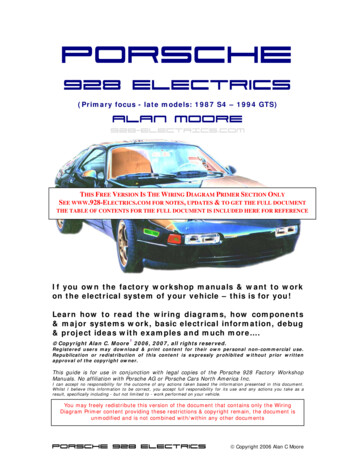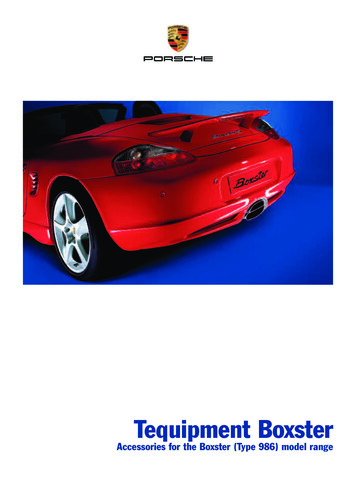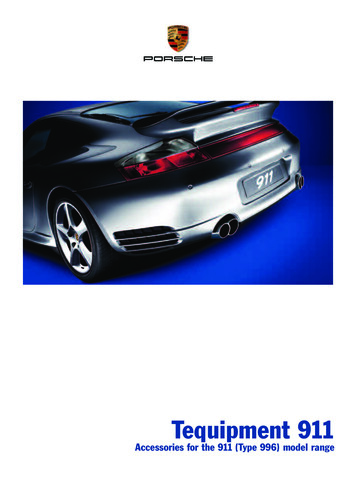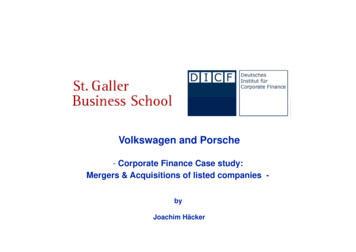
Transcription
Porsche EngineeringMagazineMacan Models: Fuel consumption (combined) 9.2 – 6.1 l/100 km; C02 emissions (combined) 216 – 159 g/km; Efficiency class: E–BCUSTOMERS & MARKETS Records on the circular track at NardòPORSCHE UP CLOSE Battery development for the Porsche 919 HybridENGINEERING INSIGHTS High-voltage testing from the cell to the batteryISSUE 2 / 2014www.porsche-engineering.comIntelligentThermal ManagementInsight into new solutions
It’s nice to seegreat ideas gain ground.
Dear Readers,We would like to welcome you to this issue witha friendly “ni hao.” Our new location in Shanghai willshortly be opening its doors. For over 20 years, we’ve beendevoting ourselves to the specific requirements of our Chinese customers. Thus, the foundation of this subsidiary isthe logical consequence of our two decades of involvementin China—a tradition-infused step into the future.The focus of this issue—thermal management—has a number of parallels with this: a traditional topic in the fieldof vehicle development, but one which, with a view tofuture-oriented mobility and alternative drive technologies,is becoming ever more diverse and complex. More thanenough reason for us to take a closer look at this matter,from function development to temperature managementfor batteries, in the spirit of our commitment to forwardlooking and “intelligent thermal management.”Malte Radmann and Dirk Lappe,Managing Directors of Porsche EngineeringAbout Porsche EngineeringCreating forward-looking solutions was the standardset by Ferdinand Porsche when he started his designoffice in 1931. In doing so, he laid the foundation fortoday’s engineering services by Porsche. We renewour commitment to that example with each new projectthat we carry out for our customers.The scope of services provided by Porsche Engineeringranges from the design of individual componentsto the planning and execution of complete vehicledevelopments, and is also transferred to other sectorsbeyond the automotive industry.One special highlight this year for Porsche was the returnto Le Mans. Vehicle development of the 919 Hybrid andultimately the spectacular race itself have been a major focus of this year. In our “Le Mans” article, we take anotherlook at the event and also report on the special challengesthat had to be mastered in the battery development processfor the 919 Hybrid.You’ve learned about the special features of our testinggrounds in Nardò in previous issues of the magazine. Joinus this time for a spin on the circular track in “A PerfectGround for Records—Nardò,” as we take a look back atthe most fascinating records of recent years.We hope you enjoy this issueof the Porsche Engineering Magazine.Sincerely,Malte Radmann and Dirk LappeEditorialPorsche Engineering MagazinE3
26Customers & MarketsRecords in NardòHistory is written in Nardò. Again and again.We take a look at some of the most exciting recorddrives of recent years.
25.6 C18.2 C22.2 C1222STATE OF RATURELow1732inteLLiGenttHermaL manaGement12 efficient interactionHolistic thermal managementfor future needs17 intelligent FunctionsFunction development forcooling systems22 optimal Battery temperaturemanagementNew solutions for functionalityand range38Customers & marketsenGineerinG insiGHts26 nardòA perfect ground for records38 keeping CurrentTesting from the cellto the batteryPorsCHe uP CLose32 Le mansPorsche returns to therace track03 Editorial06 News44 Imprint36 919 HybridBattery developmentfor Le MansmaCan modeLs: Fuel consumption (combined)9.2 – 6.1 l/100 km; C02 emissions (combined)216 – 159 g/km; Efficiency class: E–BContentsPorsche engineering MAGAZINE5
�司保时捷工程(Porsche �上海)有限公司(Porsche Engineering Shanghai Co., 民(Malte �、试验台架和实践方面密切交流。
Porsche Engineering FoundsSubsidiary in ChinaWith the foundation of a subsidiary, Porsche Engineeringis expanding its traditionally strong engagement in Asia: ThePorsche Engineering (Shanghai) Co., Ltd. will open in Chinawith the beginning of the new year.Besides Prague and Nardò, Shanghai will become the thirdlocation outside of Germany. As a result of a perfect integration of the locations it is for sure that the customers alwaysreceive holistic premium engineering services for future-orientedmobility. In Shanghai, the Porsche engineers will concentrateon proven core competencies of overall vehicle developmentand system development.NewsPorsche has a strong tradition of working with Chinese customers—engineering services have been offered in China forover 20 years. “Our customers in China place great importanceon integrated project teams for best cooperation,” says CEOMalte Radmann, “and with our new location in Shanghai,we’ll be able to fulfill that demand even better in the future.”One important component of the engagement in China is thecollaboration with Tongji University in Shanghai. A collaboration agreement was signed in June of this year for a wideranging cooperation. Based on the example of the successfulcooperation between the Prague location and the technicaluniversity there, the collaboration in Shanghai will also strivefor a fruitful exchange in terms of science, research, teaching,testing facilities and practical experience. n
develoPmenT cenTereXPandedgreenTec aWardsPresenTaTionWork-liFe balance aTPorsche engineeringWith the putting into operation ofthe new design studio together with aconception building, the aero-acousticwind tunnel and the electronics integration center, on July 18, 2014, thecompletion of an important step in theexpansion of the Weissach Development Center was concluded. By 2016,a new powertrain testing building with18 test benches will be built for the development of new hybrid drives as wellas new combustion engines and electricmotors. Engineering services for external customers will also profit from thesenew high-tech facilities. With these investments, Porsche is further expanding its core competencies and creatingnew resources not only for its owndevelopments; through the symbioticconnection between sports car seriesdevelopment and engineering services,these resources will also be available forexternal projects. nAt this year’s awards ceremony forthe GreenTec Awards—Europe’s biggestenvironmental and business award—Malte Radmann, CEO of the PorscheEngineering Group GmbH deliveredthe speech in honor of the winner inthe automobility category. The victorwas the RUBIN project, a collaborationbetween the tire manufacturer Continental and the Fraunhofer Institute forMolecular Biology and Applied Ecology.The aim of the project is to further develop the yield of natural rubber fromRussian dandelion plants and also itscultivation for industrial use. The prizes have been awarded for outstandingenvironmental engagement and greentechnology since 2008. This year theaward was presented for the first timein cooperation with Messe München asthe opening event of the world’s largestenvironmental trade fair—the IFAT. nThe success of any company isbased on motivated and capable employees, and a good work-life balanceis a fundamental factor in promotingthat. Porsche Engineering offers flexible, individualized work models toenable employees to successfully balance their family, free-time and working lives. And it’s not only employeeswho benefit—students receive optimalsupport as well. One current exampleof this is the professional athlete Jonathan Scholz, handball player for thefirst-league club SG BBM Bietigheim.The mechanical engineering studenthas been with Porsche Engineering asan intern in the engine design department since the beginning of September.A flexible working schedule enables himto combine the regular training activities that a professional sports career requires with important practical experience for his studies. n8Porsche engineering MagazinEneWs
Newsprizes for “DrivingTechnologies” Image FilmPorsche Strengthensits Presence in NardòThe new Porsche Engineering corporate film “Driving Technologies” hasbeen honored with two internationalfilm prizes: It received a Gold Awardat the Communicator Awards in NewYork and a Silver Victoria from theInternationale Wirtschaftsfilmtage inVienna. The film shows the companyas an innovative engineering servicesprovider for future-oriented mobility.The film focuses in particular on the employees and their engineering expertise.What makes the film special is its trailerlike effect that has been unprecedentedin the world of corporate videos. nIn a visit to Stuttgart-Zuffenhausenby Nichi Vendola and Angela Barbanente—president and vice president ofthe southern Italian region of Apulia,Porsche and the Apulian political leadersjointly reaffirmed their partnership forthe strategic development of the NardòTechnical Center and the region of Apulia. “The Nardò Technical Center withits rich array of facilities has becomean integral part of the holistic Porscheengineering services and the Porscheconcern itself,” said Matthias Müller,Chairman of the Executive Board ofDr. Ing. h. c. F. Porsche AG. Porscheplans large-scale investments in theproving ground. Nichi Vendola emphasized that Porsche and the Nardò Technical Center are important partners forthe region: “With Porsche we will continue to develop our region in a positivedirection in terms of economic strength,jobs and infrastructure.” m/watch?v nJL9v8KXmmoNEWSPorsche Engineering Magazine9
–30 10Porsche Engineering Magazine–20 INTELLIGENT THERMAL MANAGEMENT–10
IntelligentThermalManagement0 10 20 30 Thermal management ensures that temperatures in the vehicle are maintainedwithin an optimum range. Mastering the challenge involves an extensive range of tasksand applications requiring intelligent solutions. Yet thermal management is aboutmuch more than keeping a cool head. One goal, for instance, is to direct heat flows ina way that reduces fuel consumption while improving interior comfort. An essentialchallenge in creating forward-looking mobility.Within this broad subject, there are various sub-areas that come into play—thus onthe following pages we describe the efficient interplay between component protection,comfort and emissions reduction. Two other vital aspects are also discussed: functiondevelopment and battery temperature management.INTELLIGENT THERMAL MANAGEMENTPorsche Engineering Magazine11
THERMAL MANAGEMENT– 30 – 20 – 10 0 10 20 EfficientInteractionThe increasing electrification of the powertrain has given rise to new challengesin many areas of vehicle development. In the last edition, we took a brief look atthe significance of thermal management in the area of electric motors and we wouldnow like to explore this interesting topic in more detail.By Björn PehnertPhotos by Jörg EberlAn essential part of the development of every vehicle: testing in a climatic wind tunnel12Porsche Engineering MagazineINTELLIGENT THERMAL MANAGEMENT30
Macan Models: Fuel consumption (combined)9.2 – 6.1 l/100 km; C02 emissions (combined)216 – 159 g/km; Efficiency class: E–BSimulation of extremeconditions in a climaticwind tunnelThermal managementThe field of thermal managementoriginally arose from the need to protect components, in particular the engine,transmission, and all other parts in theengine compartment. Modern thermalmanagement now has three core areas,two of which are relatively new: improving comfort and reducing emissions.These individual areas will be discussedin detail on the following pages.coolant radiator is insufficient and further coolers have to be used.Several thousand liters of air per second are required to discharge these highcapacities to the environment via thecooler. A large part of the overall engine heat does not flow into the coolant,but is discharged into the atmosphere bymeans of convection.The potential heating of the enginecompartment due to this mechanismis a further focus of component pro-tection—heat protection. If the enginecompartment is overheated, components such as engine control units, sparkcoils or plugs can exceed their thresholdtemperatures. Reflectors, air vents, andactive ventilation from the subfloor orhood are used to counteract these hightemperatures.Even if threshold temperatures are notexceeded, lowering the temperature canbe sensible, for example to ensure thatcomponents can be operated more efficiently. ›Component protectionNearly every component in a vehiclehas a threshold temperature range inwhich it can operate. Keeping withinthis range is the focus of the component protection aspect of thermal management. An example of this is theengine, which must not be operated intemperature ranges in which cavitation(the formation and disintegration ofsteam-filled cavities in liquids), knocking, or thermo-mechanical stress cancause damage or result in a breakdown.This means that heat currents of up to100 kW might have to be discharged.Above a certain waste heat level onePreparing a cooler on a test benchINTELLIGENT THERMAL MANAGEMENTPorsche Engineering Magazine13
Comfort—warm feet and a cool headoRIGINALHEAT-PRoTEcTEdThe second core area of thermal management is improving the comfort, illustrated here by the appropriate air conditioning of the vehicle cabin. Moderncombustion engines and particularlyhybrid and electric vehicles produce solittle heat at low loads that sufficientinterior heating is no longer possiblewith conventional methods. Though, inorder to provide the necessary levels ofcomfort in the cabin, additional heating units are used to compensate for theheat deficit.Temperature (C)Representation of a simulated temperature reduction at a generatorwith intelligent heat protection measuresThe figure above shows the result ofheat protection measures for a generator. A two-component heat protectionplate has considerably reduced the heatexerted on the generator by the exhaustsystem. The generator temperature hasbeen considerably decreased, with theresult that efficiency could be raisedfrom 70 percent to 90 percent. As thethermally protected generator now hada considerably higher output, it couldbe replaced by a smaller, lighter, andcheaper component.Ensuring component protection has longbeen an established part of the series development of conventional vehicles. Onearea where new challenges and specialrequirements are arising is the thermalmanagement of (hybrid) electric vehicles.New heat-conducting materials andcooling concepts are being used to ensure component protection in vehicleswith alternative drive systems. Graphite, heat pipes, and vapor chambers areapproaches currently being developedto make the best use of hybrid components and to protect them againstundercooling and overheating. In particular, maintaining the optimum tem-14Porsche Engineering MagazinEperature for batteries has proven to bevery complex, as the different outputrequirements and cell types require different approaches. The article “Optimal Battery Temperature Management”(page 22) provides a deeper insight intothe design of such systems.One technological component in thisarea that is gaining in importance isthe heat pump that applies energy totransfer low temperatures to higherheat levels. When the heat transfer runsfrom high levels to a low temperaturelevel, the term used is air conditioning.The heat pump or air conditioning system can be driven thermally, thermoelectrically, or by a compressor. As analternative to using a heat pump as anThermo-acousticgeneratorHeat pumpHigh temperatureLow temperatureStackHeat ctional principle of a thermo-acoustic cooling systemINTELLIGENT THERMAL MANAGEMENTAmbienttemperature
FunctionsMODELTEST BENCHVALIDATION1D SIMULATIONVALIDATIONcodeCONTROL UNITAPPLICATIONFunctional development process sequence in thermal managementadditional heating unit, PTC heaters canbe used that provide warmth in a highlydynamic way.The rising number of technologicallydifferent devices makes it increasinglymore complex to find the optimum concept for one particular vehicle. To beable to compare various cooling concepts quickly and meaningfully, PorscheEngineering has developed several simulation and calculation tools.Compressor-driven cooling systemsare used in conventional cabin air conditioning. In this case a hermeticallysealed circuit compresses a gaseous medium with a compressor. This is liquefied in the downstream condenser andthe compressed hot coolant gives offits heat into the atmosphere. The heatcan be given off into the air at the frontend of the vehicle or alternatively into acooling circuit integrated in the overallvehicle cooling system. The liquid coolant is fed to a vaporizer via a throttle,turning from liquid to gas and therebyacquiring heat. The warmer cabin air isfed into the vaporizer and cooled, creating a pleasant climate in the vehicleinterior at high ambient temperatures.In winter, this process can be reversedso that the air conditioning system cannow be used for heating and therebyfunctions as a heat pump.The refrigerant R134a is largely used inpassenger car air conditioning systems,which in coming years will be replacedby more environmentally friendly alternatives. In addition to R1234yf, naturalcoolants such as carbon dioxide (CO2),referred to as R744 by specialists in thefield, will be used. The alternative coolant CO2 requires especially innovativesolutions to be capable of creating efficient cooling / heating circuits for passengers and components.INTELLIGENT THERMAL MANAGEMENTThe thermal dynamics experts atPorsche Engineering have even moreinnovative solutions in their repertoire.An interesting example of this is thethermo-acoustic air conditioning system (see illustration on the left page).Here, thermal energy from the engineis used to start oscillations in a resonator. These oscillations are used to drivea cooling system. For this to function,in addition to the resonator, so-calledstacks are required. Stacks are components that can convert thermal energyinto oscillations and vice versa. A stack(driver) generates a pressure gradientvia an externally created temperaturegradient and thereby an acoustic impulse in the resonator. The excitationcreated is then converted into a temperature gradient by the second stack(generator stack) so that the hot andcold sides that arise here can be usedas a heat pump. This alternative has nomoving parts and has the advan- ›Porsche Engineering Magazine15
tage that it only requires engine heat tooperate.mance while taking the engine geometry,number of cylinders and other parameters into account.performance of a thermal managementsystem integrated in a vehicle.Emissions reductionThe constant further development ofthe combustion engine and continuously falling emission and consumptionvalues means the demands on thermalmanagement are increasing. Downsizing sees the use of supercharged enginesthat have a high specific output, a widerevving range with maximum torque,and good transient response characteristics. However, the exhaust gas turbocharging required for this results ingreater levels of residual gas contentand higher temperatures and pressuresin the combustion chamber that in turnresult in an increased tendency towardsknocking in the engine. Later ignitionis required to prevent knocking. Thismeans a later combustion center ofgravity and therefore a lower engineefficiency level.Complete packagethermal managementIn addition to the fields of componentprotection and comfort, modern thermalmanagement is also playing an increasingly important role in reducing CO2emissions for example. The familiar engine thermostat alone is no longer sufficient for the thermal management ofmodern engines. While heating up, everydegree more of engine temperature cancontribute to reducing emissions.To be able to efficiently use the wasteheat generated by the engine, standingwater, integrated exhaust manifolds, andsplit cooling are used. So that useful engine heat is not lost into the atmosphere,engine encapsulation and the correctchoice of cooling system dimensioningmust be given exact consideration. Optimum valve control also plays an important role here as it contributes to minimizing CO2 emissions and waste heat.The effective cooling system size can beinfluenced by valves such as thermostatsor proportional valves. To increase thedynamic response of the cooling systemfor example, its size is scaled down, bydisconnecting thermal ballast such ascompensating reservoirs, air extractionducts or non-required plate heat exchangers via the controller.One basic task of thermal managementnot yet discussed is the determinationof the heat energy transferred to thecoolant. In conjunction with the analysis of real engine heat balances on thetest bench, simulations are used todesign the cooling system in the firstdevelopment phases. Porsche Engineering uses its own developed software forthis. This determines the relationshipbetween heat being transferred to thecoolant and effective engine perfor-16Porsche Engineering MagazineTo counteract this effect, Porsche Engineering is examining the possibilitiesof reducing intake temperatures. Coolerintake air reduces the likelihood ofknocking as well as the exhaust temperature, thereby increasing efficiencyand reducing CO2 output. Measuressuch as more efficient charge air coolersand using super cooling or refrigerantcooling are being investigated with theaim of reducing intake temperatures.Emissions cannot only be reduced bycomponents and parts; intelligent functions in the vehicle also have a role toplay (see article "Intelligent Functions").It is important that the many components in a vehicle cooling system aredoing the right thing at the right time.This is the only way to achieve goodoverall levels of efficiency and performance. Here it is also necessary thatnew functions are developed and applied in vehicle management systems.Only a combination of software andhardware can obtain the maximumINTELLIGENT THERMAL MANAGEMENTToday’s thermal management with itsthree major fields of component protection, comfort, and emissions reductiontakes on an important superdisciplinaryfunction in the overall vehicle. Conventional cooling concepts are increasinglybeing stretched to their limits and innovative approaches are gaining inimportance. The increasing complexity requires a better understanding anda greater degree of integration of thefields involved. n
Thermomanagement– 30 – 20 – 10 0 10 20 30 IntelligenteFunktionenFür ein aktives Thermomanagement in Fahrzeugen ist die Funktionsentwicklung fürKühlsysteme eine Grundvoraussetzung. In diesem Artikel erfahren Sie, wie genau diesebeiden Themen zusammenhängen und wie Porsche Engineering das optimale Zusammenspielim Entwicklungsprozess und in der Anwendung sicherstellt.Text: Thomas WarbeckEin leistungsfähiges und effizientesThermomanagement in Fahrzeugenerfordert nicht nur eine sorgfältige Auslegung von Kühlkreisläufen, sondernauch eine intelligente Steuerung der imKreislauf verbauten Teile. Hierbei wirdstets eine bedarfsgerechte Kühlung angestrebt, was bedeutet, dass jede Komponente wie zum Beispiel Verbrennungsmotor, Batterie oder E-Maschine imoptimalen Betriebstemperaturbereichliegt und im Kühlsystem verbaute Lüfterund Pumpen nicht unnötig in Betriebsind. Dadurch wird eine höhere Reichweite sowohl von brennstoffgetriebenenals auch von Elektrofahrzeugen ermöglicht. So werden beispielsweise Kühlerlüfter an kalten Tagen im Winter erst beihöheren Kühlwassertemperaturen zugeschaltet als im Sommer, wenn selbstnach Abstellen des Fahrzeugs für kurzeZeit oft noch Kühl bedarf besteht, umeine lokale Über hitzung von Kühlmitteln und Bauteilen zu vermeiden.Intelligentes ThermomanagementSolche Funktionen müssen im Entwicklungsprozess erarbeitet und schließlichim Motorsteuergerät hinterlegt werden.Besonders bei Prototypensteuergerätenerweist es sich als vorteilhaft, wenn sieschnell an neue Anforderungen undMessdaten angepasst werden könnenund mit der eigentlichen Entwicklungdes Kühlkreislaufs einhergehen.Von den Anfängen der Wasserkühlungzu schaltbaren Kühlkreisläufen mitKennfeldthermostatDie einfachste und älteste Art der Motorwasserkühlung ist die Thermosiphonkühlung. Hier wird Wasser nur aufgrundder Dichteunterschiede von warmemund kaltem Wasser in Motor und Kühlerumgewälzt. Nachdem warmes Kühlwasser vom Motor in den Kühler gelangt ist,wird es abgekühlt, sinkt nach unten undwird von dort dem Motor wieder ›Porsche Engineering Magazin17
�lzenzum kühlenhochladezustandhochumgebungs temperaturniedrigzelltemperaturniedrigumwälzenzum enzum kühlenhochumgebungs temperaturniedrigzelltemperaturniedrigumwälzenzum kühlenSchematische Darstellung einer Batteriekühllogik als Basis für die Funktionsentwicklungzugeführt. Durch Hinzufügen eines mechanisch angetriebenen Kühlerlüfterskonnte Anfang des 20. Jahrhunderts dieEffizienz gesteigert werden, auch wenneine Regelung zu diesem Zeitpunkt nochnicht möglich war.Der Einsatz einer Wasserpumpe verbesserte die Umwälzung, was zu höherenKühlleistungen führte. Um eine schnellere Aufheizung des Motors nach demKaltstart zu ermöglichen, wurde in denKreislauf schließlich ein Thermostatventil eingesetzt, wodurch das Kühlwassertemperaturabhängig über die Kühleroder an ihnen vorbeigeleitet werdenkonnte. Somit hatte das erste regelndeElement Einzug in den Kühlkreislaufgefunden.Stellglieder in KühlkreisläufenWährend sich einfache Thermostate beiErreichen der Betriebstemperatur öffnen und dem Kühlwasser den Weg zuden Kühlern freigeben, lassen sich moderne Varianten so ansteuern, dass die18Porsche Engineering MagazinÖffnungstemperatur des Thermostatventils zum Beispiel in Abhängigkeitvon der Motorlast angepasst werdenkann. Anfänglich wurde ein Lüfter mechanisch an den Motor gekoppelt undlief somit bei niedrigen Drehzahlen imStand langsam und im Fahrzustand mitgroßem Kühlluftmassenstrom entsprechend schnell. Heute ist eine elektrischeAnsteuerung möglich, die ein umgekehrtes Verhalten erzeugt.In Fahrzeugen mit Verbrennungsmotorwerden mechanisch drehzahlabhängi ge Wasserpumpen derzeit noch standardmäßig verbaut, jedoch sind elektrischeund damit flexibel regelbare Wasserpumpen in Serienanwendungen immer häufiger vorzufinden. Hinzu kommen je nachAnwendung verschiedene Ventile, diezum Beispiel die Innenraumheizung vomKreislauf zu- oder abschalten können.Mehr als nur ein KühlkreislaufIn modernen Fahrzeugen wie zum Beispiel Hybriden ist ein einzelner KreislaufIntelligentes Thermomanagementaufgrund der Vielzahl an unterschiedlichzu temperierenden Komponenten längstnicht mehr ausreichend. Das Kühlwasser im Verbrennungsmotor kann nichtzur Temperierung von Batterien benutztwerden, da deren Betriebstemperaturin der Regel weitaus niedriger ist. DieAbstimmung und der Wärmeaustauschzwischen den Kühlkreisläufen sindebenfalls wichtige Teile des Thermomanagements, für die Kühlstrategien entwickelt und in Steuergeräte funktionenumgesetzt werden.Stetig steigende Nachfrage nachangepassten FunktionenInsbesondere aufgrund der immer strenger werdenden EU-Vorgaben hinsichtlich des CO2-Ausstoßes und anderenEmissionen wird eine intelligente Steuerung des Kühlsystems immer wichtiger.Für den Kunden sind darüber hinaus imFalle verschiedener hinterlegter Modiein verminderter Verbrauch, gesteigerter Komfort oder auch herausragendePerformance direkt spürbare Vorteile.
kühlung auskühlmodus 1kühlmodus 2kühlmodus 3kühlmodus 4Funktionsentwicklung als Prozess,Entwicklung von funktionellenKühlkreisläufenDie grundlegenden Funktionen imKühlsystem werden bereits währendder Auslegung des Kühlkreislaufesbestimmt. Verbaute Aktuatoren undSchnittstellen zwischen verschiedenenKreisläufen geben einen gewissen Spielraum vor. Es stellt sich die Frage, anhand welcher gemessenen Werte vonTemperaturen, Drücken oder auch vorgenommenen Einstellungen durch denEndkunden welche Aktuatoren verstelltwerden sollen.Zunächst werden die zu verwendendenEingangsgrößen festgelegt und somitbestimmt, auf welche Parameter dasKühlsystem reagieren soll. Solche Eingangsgrößen können beispielsweise dieKühlwassertemperatur oder die Umgebungstemperatur sein, aber auch Drehzahl und Last des Verbrennungsmotors.Im Batteriekühlkreislauf ist darüber hinaus auch der Ladezustand zu berücksichtigen, da die von den Zellen abgegebeneVerlustleistung und damit der Kühlbedarf hiervon abhängig sind. Auch füreine elektrisch angeschlossene Batterieheizung ist diese Größe interessant.Die Ausgangssignale sind überwiegenddurch die verbauten Aktuatoren vorgegeben, jedoch können auch weitereSignale ausgegeben werden, die ananderen Stellen der Motorsteuergerätsoftware Verwendung finden. Dies kannbeispielsweise dann der Fall sein, wenndie Anforderung zum Abschalten derKlimaanlage ans Motorsteuergerät gesendet werden soll.Nach Definition der Ein- und Ausgangssignale werden die eigentlichen Funktio nen beschrieben. In Abhängigkeit vomBetriebsmodus, dem Ladezustand derBatterie (SOC, engl. „state of charge“),der maximalen Zelltemperatur und derUmgebungstemperatur werden für jeweils unterschiedliche Kombinationenandere Setups gewählt. Wichtig istebenso die Definition von sinnvollenParametern, die während der Applikationim Fahrzeug noch einfach geändert werden können. Grenzwerte für den Ladezustand, die Umgebungs- und maximaleZelltemperatur sind Beispiele hierfür.Modellierung in MATLAB / SimulinkNach dem Entwurf müssen die gewünschten Funktionen mithilfe geeigneter Software modelliert werden. BeiPorsche Engineering g
About Porsche Engineering Creating forward-looking solutions was the standard set by Ferdinand Porsche when he started his design office in 1931. In doing so, he laid the foundation for today’s engineering services by Porsche. We renew our commitment to that example w









